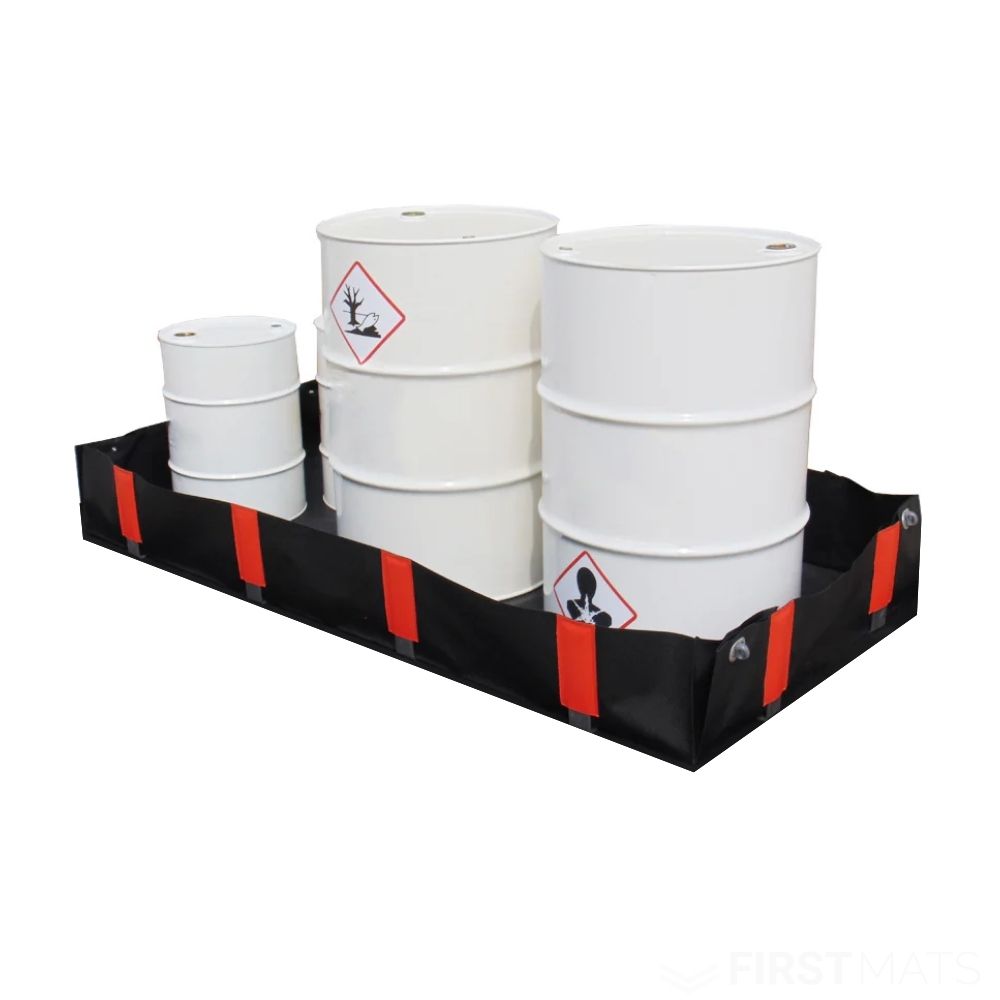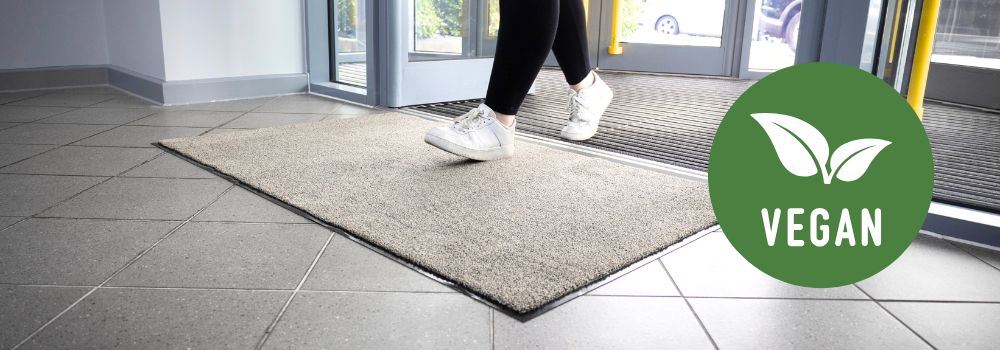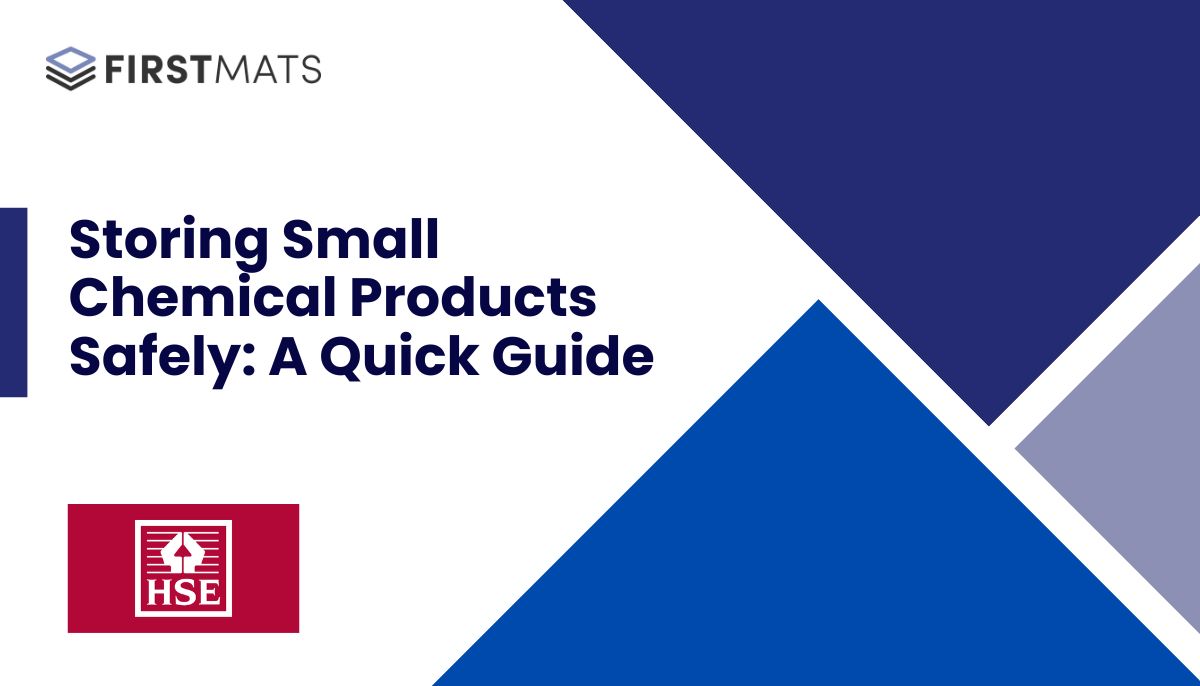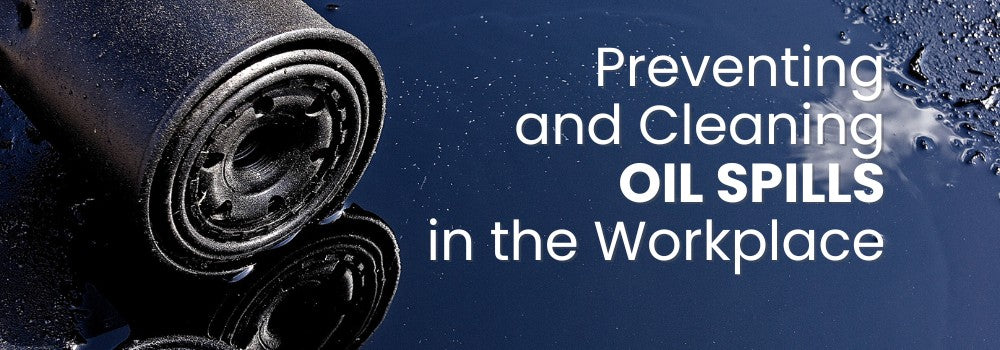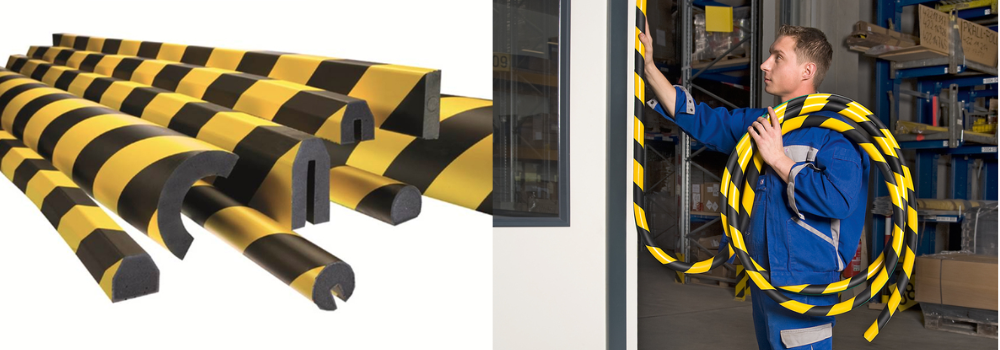Hazardous Storage Guide

by Richard O'Connor
Aug 11, 2021 | *12 minutes to readWherever chemicals are stored, there is a risk of fire, chemical reactions, and pressure build-up. For this reason, it is imperative to store chemicals and other hazardous liquids with great care and attention and adhere to Health and Safety Executive (HSE) guidelines and best practice principles. Our Hazardous Storage Guide provides essential guidance around metal workplace Storage Cabinets, spill control management and general health and safety best practices.
Index:
- Why is safe storage important?
- What are the main storage regulations?
- What is a risk assessment, and how to complete one?
- How to store flammable liquids safely
- How to store hazardous chemicals safely
- How to store oils safely
- What is COSHH?
- What makes storage COSHH compliant?
- How to deal with a chemical or oil spill
- How can spill pallets and kits help?
Why is safe storage necessary?
Although storing chemicals may sound simple, some rules and guidelines should be followed to keep your workforce and workplace safe.
The unsafe storage of chemicals, directly and indirectly, impacts people’s health. If stored incorrectly, fumes and gases can escape, which can have short-term effects such as burns and headaches to long-term impacts, including lifelong breathing problems and fatal injuries.
Product life is also an essential factor when it comes to safe storage. Many chemicals tend to have a long lifespan but even so, storing all chemicals correctly allows you to keep an eye on how much shelf life they have left. This can help reduce environmental waste and save you money in the long run.
The environment is also an important factor to consider regarding safe storage. Once a chemical is spilt, contamination occurs, and there is no way of reversing it. This can adversely impact marine life and aquatic plants.
What are the main storage regulations?
Various rules and regulations have been set to make the storage of chemicals as safe as possible. Below are three main acts of legislation that have been passed surrounding chemicals and hazardous substances.
COSHH - Control of Substances Hazardous to Health (2002)
This is by far the most significant piece of legislation surrounding hazardous substances in the UK. It covers most chemical and biological chemicals that are likely to be used in the workplace and has been set to control exposure and protect workers' health.
DSEAR – Dangerous Substances and Explosive Atmospheres Regulations (2002)
This covers all flammable, oxidative, and explosive materials by marking them as dangerous. This means that employers must identify all materials that are at risk of exploding or catching on fire and put a plan into place for handling and storing them. There is also a need for an emergency plan to be put into place, as well as a requirement to highlight possible sources of ignition to keep all chemicals under this act as far away as possible from those areas.
Control of Asbestos Regulations (2012)
Before 2000, asbestos was widely used within building materials and is commonly found in older building structures. The legislation requires the duty holder to conduct an assessment to find out whether there is any asbestos resent or not. If it is found, but in good condition, it should be closely monitored to ensure it doesn’t become damaged.
If asbestos is disturbed, it becomes hazardous as the fibres are toxic to breathe in. Always contact a trained professional to remove asbestos if needed.
Hazardous Storage Risk Assessments
Any workplace that handles dangerous materials and/or chemicals must complete a risk assessment. The reasons for carrying out a risk assessment include:
- Identifying what the hazards are
- Deciding how to prevent risky situations from occurring
- Taking steps to minimise harm to staff and visitors
- Providing control methods
- Providing information and training to employees
- Planning for emergencies
Carrying out a risk assessment may seem like a long and complex process, but in reality, it only takes a couple of hours at most and ensures the safety of everyone within your business.
Each workplace will have a slightly different assessment procedure in place, but generally, five main steps need to be completed.
- Gathering information: Take a walk around your workplace and list all the hazardous substances and chemicals found.
- Evaluating risks: Take a closer look at each substance to find out how it could harm health. This can be done by obtaining the Material Safety Data Sheets (MSDS) for a substance or by contacting the manufacturer/supplier.
- Deciding on the measures: Now that all the risks have been identified, the correct steps to prevent any harm to anyone within the workplace need to be taken. This could include assessing the current control measures in place to decide if they meet regulations or if they need to be updated to comply with all the guidelines that are out in place.
- Recording the assessment: All the information that has been gathered and the measures that have been put in place need to be recorded in an understandable and straightforward manner. This is to ensure information can be easily accessed by anyone who would like to know more about the safety procedures put into place.
- Reviewing the assessment: The risk assessment should be reviewed at frequent intervals throughout the year to ensure all the information is still up to date and relevant. The risk assessment should be updated accordingly if new substances or chemicals are added, or if anything changes regarding the control methods.
It is a statutory requirement and responsible health and safety practice to monitor and maintain the inventory of chemicals on site. This includes ensuring that chemicals are clearly labelled and correctly stored, and expiry dates are strictly adhered to. That’s why this activity of carrying out a risk assessment should be done at least annually.
Read More: Storage cabinets are available in different colours to make it easier for users to know what type of hazardous liquid they are storing. For example, yellow cabinets for Chemicals and red cabinets for Flammables.
How to store flammable liquids safely.
Flammable liquids can be found in most workplaces throughout the country. This is because common substances, such as petroleum, are widely used in many environments, from agriculture to healthcare to even the fashion industry.
This means the storage of flammable liquids not only needs to be controlled in terms of quantity but also in how they are stored. The Health and Safety Executive (HSE) recommends keeping the quantities of flammable substances within the workplace to a minimum to provide mitigation and protect against foreseeable incidents.
How to store
When not in use, flammable substances should be kept in closed, fire-resistant containers that have been designed to retain spills. These containers should be kept away from other dangerous substances in an area out of reach from unauthorised access.
Important note: Flammable liquids with a flashpoint of 55oC or higher should be kept in quantities of no more than 250 litres per container to represent safe practice.[1]
How to store hazardous chemicals safely.
The storage of hazardous chemicals varies greatly depending on the type of chemical that is being handled. One of the main ways to ensure that the chemicals your business handles are stored correctly and safely is to follow UK REACH.
REACH stands for Registration, Evaluation, Authorisation and Restriction of Chemicals and aims to provide a high level of protection of human health and the environment from using chemicals.
If your company has any type of chemicals on site, chances are you will be affected by the UK REACH regulations. This is because no matter the company size or sector you work in, REACH regulates the safe use of substances across all industries. If you would like to find out how to store your chemicals safely, you can contact the manufacturer or supplier for more information or click here to find out more about REACH[2].
Also, using bunding where chemicals are stored is standard safety practice, and for a good reason. Bunds and spill trays are placed under chemical storage containers and, in the event of a leak or spill, act as a protective guard for both the environment and personnel. This kind of safeguard should be inspected every three years at a minimum.
How to store oils safely.
As with chemicals and flammable substances, the storage of oils is also regulated by strict guidelines to ensure the safety of the people who handle them.
If your oil container can hold over 201 litres of certain oil types, including petrol, biofuels, and synthetic or biodegradable oils, then a special oil tank must be used for storage purposes.[3] This needs to be inspected every year by a professional to ensure everything is in fully working order and is safe to continue using for oil storage.
For more information regarding oil storage, you can visit the official guidance website here[4].
What is COSHH?
When it comes to chemical and hazardous substances and storage, COSHH is a term that comes up a lot. But what exactly is COSHH?
COSHH stands for Control of Substances Hazardous to Health and is the main regulatory guidance employers must follow. It covers everything from preventive measures to control measures on keeping exposure to hazardous substances to a minimum. This not only helps to protect employees but also decreases the risk of accidents occurring.
In the UK, lung cancer and ill health caused by hazardous substances at work affect around 12,000 people annually [5], which is why it is so important to follow the rules outlined by COSHH. Not only that, but if your company is found to be not abiding by the rules correctly, it could land you in some serious trouble, including an unlimited fine.

What makes storage COSHH compliant?
Many substances are labelled by COSHH as being hazardous, including but not limited to biological agents, fumes, asphyxiating gases and many types of chemicals.
Most types of hazardous substances need to be stored in a COSHH cabinet. This is to ensure any dangerous chemicals are securely put away to reduce the risk of harm to employees and the workplace.
To be able to decide on which type of COSHH storage best suits your needs, a risk assessment must be carried out. This not only helps identify how many cabinets may be needed by outlining what the health hazards are but also highlights the danger of certain chemicals and whether or not they need to be segregated from others.
COSHH symbols are then placed on cabinets to identify their risk, and there are a total of nine different ones which are:
- Long-term health hazard
- Explosive
- Toxic
- Flammable
- Warning
- Oxidising
- Corrosive
- Compressed gas
- Danger to the environment
All the symbols are diamond in shape and red and black in colour with easy-to-understand illustrations on them. This makes all the COSHH symbols simple to understand, allowing them to be used globally.
How to deal with a chemical or oil spill
No matter how many precautions and steps are taken to store substances correctly, spills are bound to happen. If you do find yourself in a chemical or oil spill situation, the important thing is to act fast and clean it up before it causes damage to health or the environment.
The first step is to communicate with others and let them know there has been a spill. This allows people to evacuate and stay clear of the area until the spill has been dealt with. Informing a manager or emergency response coordinator can also help get the message across and creates clear communication for all.
Next is the preparation, which includes ventilating the area and choosing the right spill kit. Ideally, both steps should be done as quickly as possible to stop the leak from getting out of hand.

Once the spill kit has been opened, it's time to stop and contain the spill. The kit should contain everything that is needed to complete this, such as pads, socks and pillows. Absorbent equipment should be placed around the spill to contain it first, and then the rest of the spill can be mopped up with the remaining absorbent pads.
Once the spill has been contained, the waste needs to be disposed of. It is important to note that waste from a spill kit should not be placed in the regular bin but in a specific hazardous waste bag, which can then be taken to the right facility and disposed of correctly.
How can spill pallets and kits help?
Spill kits and pallets have been designed to make containing and cleaning up spills much faster and simpler.
Spill pallets (also known as bunded pallets) form a key line of defence against undetected leaks and spills and allow your staff to handle hazmat pallets confidently. They are designed to collect drips from leaky drums and containers and store them safely into the sump below, preventing contamination and damage to the flooring.
The Oil Storage Regulations (2001) require that for the outdoor storage of oil or fuel, a bunded pallet or similar secondary containment item must be in place to ensure any leaks or spillages are safely contained in the sump.

Spill kits, on the other hand, enable a rapid response in the event of an emergency. Different types of spill kits are available, each suited to a specific repose which includes:
- Chemical spill kits
- AdBlue spill kits
- Universal spill kits
- Oil spill kit
It is important to consider which type(s) of spill kits you need to always have ready on your premises, as choosing the right spill kit is very important, e.g., a chemical spill kit will not work on an oil spill.
All kits are also available in a variety of sizes to suit different spill volumes: from 50 litres up to spills of 240 litres. Knowing which size spill kit to get can be tough, so it is recommended that you have enough provisions to soak up around a quarter of all the liquid in storage.
Final Word
In conclusion, keeping different chemicals and hazardous substances separate from each other is the cornerstone of good chemical storage. Each storage space should also be optimised by ensuring that access is clear and easy and the area is well-ventilated with hoods, ducts, and vents in place. It should be temperature controlled, and appropriate clean-up and containment equipment must be close at hand.
Moving corrosives and acids from larger, bulk containers and drums to smaller, more manageable containers is best practice and should be done as soon as possible and whilst wearing the appropriate personal protection equipment (PPE).
References
[1] https://www.hse.gov.uk/fireandexplosion/storageflammliquids.htm
[2] https://www.hse.gov.uk/reach/whatisreach.htm
[3] https://www.gov.uk/oil-storage-regulations-and-safety/business
[4] https://www.gov.uk/oil-storage-regulations-and-safety
[5] https://www.hse.gov.uk/statistics/causdis/index.htm
Explore More Topics
Frequently Asked Questions
If you have any questions, we’re here to help
How long does delivery take?
Each product comes with a specified lead time for delivery. We'll keep you informed if there are any delays in meeting this timeline.
Typically, once you’ve finalised your order and approved the proof, it will take 4-5 business days to make and deliver your finished mat.
If my order is damaged, can I return or exchange it?
Got a problem with your order? If something's not right or you're not thrilled with the quality, just let us know within 14 days of getting it. Drop us a line, and we'll tell you what to do next—usually, it starts with you sending us a photo of the issue. Once we check that out, we'll sort you out with a refund or a new item, no fuss.
Can I get my mat delivered more quickly?
Need your item in a hurry? Just Contact us to explore the faster delivery options we might have for you!
If my custom mat is damaged, can I return or exchange it?
Got a problem with your order? If something's not right or you're not thrilled with the quality, just let us know within 14 days of getting it. Drop us a line, and we'll tell you what to do next—usually, it starts with you sending us a photo of the issue. Once we check that out, we'll sort you out with a refund or a new item, no fuss.




















